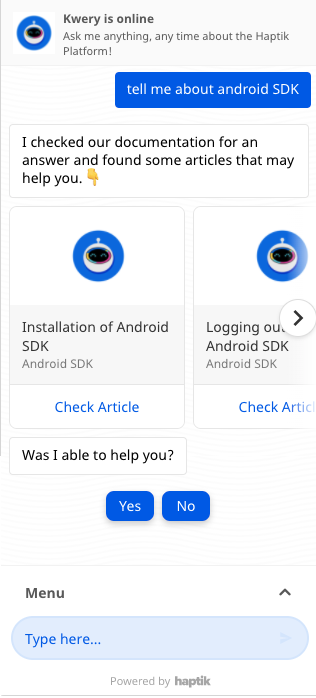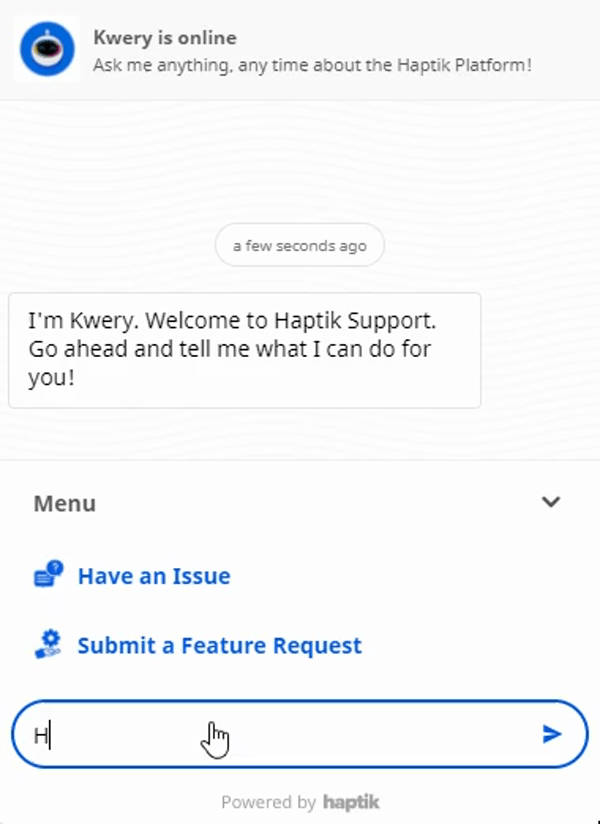What is Knowledge Base Integration?
- Getting Started
- Bot Building
- Smart Agent Chat
- Conversation Design
-
Developer Guides
Code Step Integration Static Step Integration Shopify Integration SETU Integration Exotel Integration CIBIL integration Freshdesk KMS Integration PayU Integration Zendesk Guide Integration Twilio Integration Razorpay Integration LeadSquared Integration USU(Unymira) Integration Helo(VivaConnect) Integration Salesforce KMS Integration Stripe Integration PayPal Integration CleverTap Integration Fynd Integration HubSpot Integration Magento Integration WooCommerce Integration Microsoft Dynamics 365 Integration
- Deployment
- External Agent Tool Setup
- Analytics & Reporting
- Notifications
- Commerce Plus
- Troubleshooting Guides
- Release Notes
Table of Contents
Knowledge Base Integration Points to note Analytics for Knowledge Base IntegrationKnowledge Base Integration
This is the ability of the Haptik virtual assistants to connect with third-party knowledge management systems and answer user queries. The solution works by dynamically picking the most relevant articles from the third-party knowledge base and suggesting them to the user on the virtual assistant.
The screenshot shown below, explains the same, where a user’s query “Tell me about Android SDK” is responded with the right articles from the knowledge base.

Knowledge Base can be provided by multiple vendors, and Haptik can enable those to be integrated with your virtual assistant depending on your requirements. For Example - The Haptik platform can integrate with Zendesk, i.e Zendesk Guide and USU Knowledge Solutions out of the box.
More such out-of-the-box integrations are on the Roadmap with other key knowledge base providers. To add to that, the Haptik platform has the capability to integrate with other custom or enterprises’ in-house knowledge base solutions too, as long as the content can be accessed over REST APIs.
It is important to understand what the user's experience has been while conversing with the bot, which is why we collect feedback from the users at the end of the conversational journey. The feedback collection message is shown after the article suggestions - “Was I able to help you?”. This message ONLY shows if the feedback collection is enabled for the bot on the Business Manager.
Points to note
- When a user message is received on the bot, the bot will try to find the response in the following order of priority -
- STEPs present on the Graph
- FAQ STEPs
- Articles from Knowledge Base
- Small talk
- During the course of a conversation, a user will be sent article suggestions from the Knowledge Base only -
- If the user’s message is the first message in a conversation.
- If the previous user message was responded by the bot using some STEP
The GIF here, shows the representation where the user asks "What is Conversation Studio?", to which the bot responds with a set of articles related to the user's intent, i.e. Conversation studio.

Analytics for Knowledge Base Integration
Analyzing responses coming to the Knowledge Base would be utterly important to measure its efficiency. The user messages that received article suggestions from the Knowledge Base can be analyzed on the Intelligent Analytics tool.
You can download the messages from the “Message Analysis” section on the Intelligent Analytics tool. The “Message Analysis” CSV has a column “Response Container”. The messages that receive Knowledge Base article suggestions would have the value of “Response Container” marked as “KMSResponseContainer”.
To integrate your Knowledge Base with the virtual assistant, please get in touch with your Haptik account executive or the solution consultant. You can write to us at enterprise@haptik.ai
